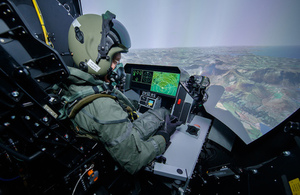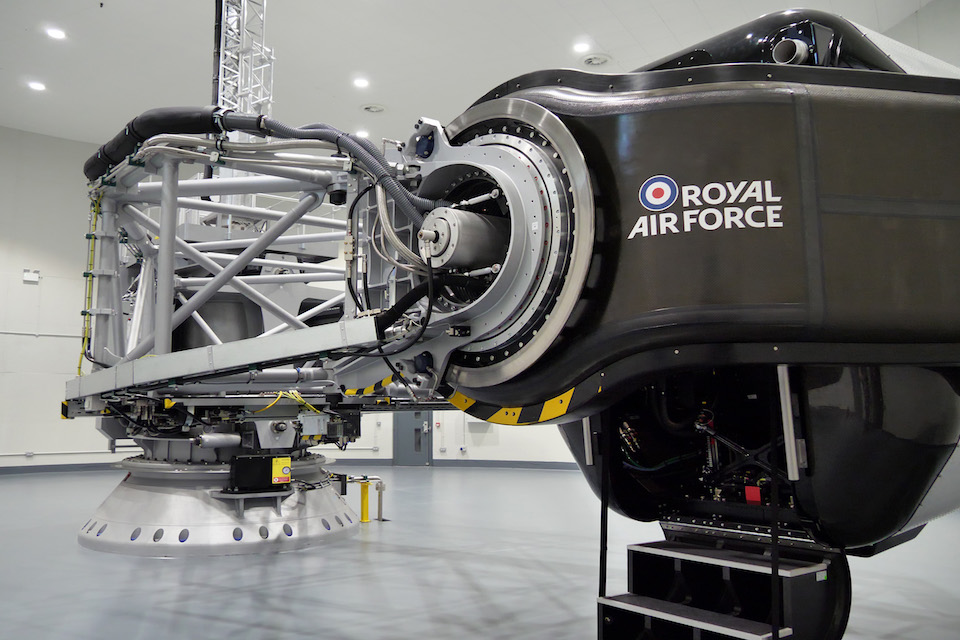New fast jet training takes off
The Chief of the Air Staff, Air Chief Marshal Sir Stephen Hillier, has opened the High-G training and test facility at RAF Cranwell today.

The new High-G training and test facility at RAF Cranwell. Crown copyright.
The £44-million project is used by fast jet pilots in the Royal Navy and Royal Air Force to replicate flight in aircraft such as the Hawk, Typhoon and new F-35 Lightning aircraft. Pilots are able to experience up to 9G, 9 times the normal gravitational pull of the Earth, and learn how to use their specialist in-cockpit flying equipment to help them cope with these stresses. The centrifuge can accelerate up to 9G in one second and rotate up to 34 times a minute.
The new facility revolutionises High-G training as pilots are not simply strapped into the device and exposed to G-force but are able to ‘fly’ as they would in a flight simulator as the pilot manoeuvres the aircraft and applies the G-force.
Chief of the Air Staff Air Chief Marshal, Sir Stephen Hillier said:
I am delighted to see our new High-G Training Facility opened today and to be able to mark this step-change in how we train our pilots. By exposing our Typhoon, Lightning and Hawk pilots to High-G forces in a tailor-made and completely controlled environment, we are significantly enhancing safety in the air and making a major contribution to our operational effectiveness. Today represents another major milestone in the RAF’s impressive modernisation programme.

Chief of the Air Staff opening the new facility at RAF Cranwell. Crown copyright.
Pilots benefit from a cockpit which closely represents that of their normal aircraft enabling them to conduct a plethora of training scenarios from air-to-air combat to dealing with in-bound missile threats.
The device will also be used to trial and test new equipment to be used on fast jet aircraft and by the pilots. This will also ensure that the testing is done in a benign environment before being trialled in live flight.
Director Air Support at DE&S, Richard Murray said:
This new and exciting facility is replacing the High-G trainer which until recently was used by defence; that dates from the 1950s and no longer matches the performance of the modern fast jet aircraft such as the F-35 and Typhoon. The centrifuge is capable of accelerating up to 9-G in just one second, but rather than just sitting in it, the replica, flyable cockpit delivers realistic and immersive training, helping to simulate real-life missions while teaching pilots to deal with acceleration and High G-forces.

The new High-G training and test facility at RAF Cranwell. Thales copyright.
The new facility at RAF Cranwell is used by fast jet pilots progressing through the UK Military Flying Training System and into their flying careers. Fast jet pilots will refresh their training at least every 5 years to keep them as safe as possible and current in the techniques used to handle High-G forces in flight.
The RAF Centre of Aviation Medicine is using the facility to train aircrew to recognise the effects of G-force, develop awareness of it and learn the physical techniques needed to counter the effects on their bodies during combat missions. Up to 300 aircrew will receive training on the centrifuge each year.
The 39-tonne centrifuge built by Thales UK has seen the company team up with world leading centrifuge specialists AMST from Austria to design and build the equipment. Thales has been training RAF aircrew since the 1930s providing over 300 complex simulators for 60 different platforms.
Thales UK Chief Executive Officer, Victor Chavez said:
Only 24 months ago we cut the turf to set this project on its way, so to see the centrifuge in full operation is a testament to great collaborative working from Thales, DE&S and the RAF. Thales has been training RAF aircrew since the 1930s, that’s more than 80 years of providing 300-plus complex simulators for 60 different platforms. The High-G Training and Test Facility is our next exciting chapter in this long-standing training partnership with the RAF.